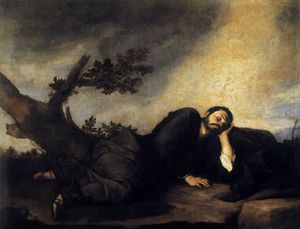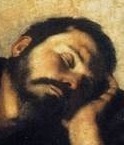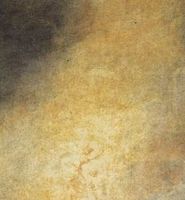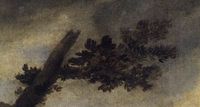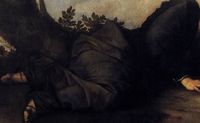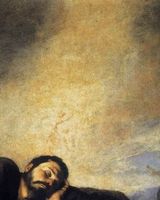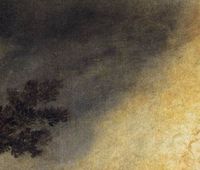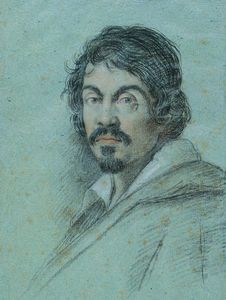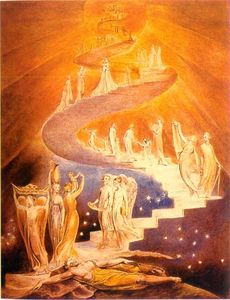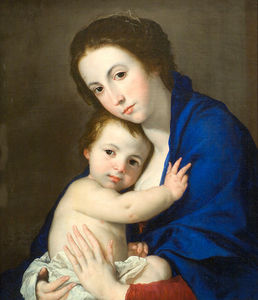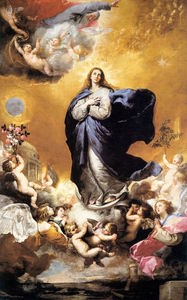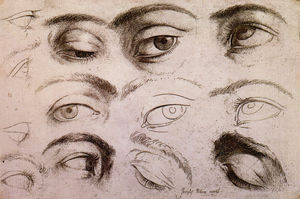Jacob's Dream
- Date of Creation:
- 1639
- Height (cm):
- 179.00
- Length (cm):
- 233.00
- Medium:
- Oil
- Support:
- Canvas
- Subject:
- Scenery
- Art Movement:
- Baroque
- Created by:
- Current Location:
- Madrid, Spain
- Displayed at:
- Museo Nacional del Prado
- Owner:
- Museo Nacional del Prado
- Jacob's Dream Page's Content
- Story / Theme
- Analysis
- Critical Reception
- Related Paintings
- Artist
- Art Period
- Bibliography
Jacob's Dream Story / Theme
By far one of Ribera's most famous paintings, the story of Jacob's Dream comes from the Old Testament book of Genesis 28: 11-19. Jacob was the younger son of Isaac and Rebekah, and as such would traditionally have been passed over in favor of his older brother Esau to receive the traditional blessing of his father. Jealous Jacob, however, was Rebekah's favorite and the two managed to trick the blind Isaac into giving Jacob the blessing while Esau was away.
After this wily scheme was uncovered, Esau was understandably enraged and eagerly began planning his vengeance. Worried by this, Rebekah told Jacob to leave home for a while until things calmed down, and sent him to the city of Haran to choose a wife.
On the first night of his journey, a cold, lonely and miserable Jacob laid down to sleep, using a less-than-comfortable rock as a pillow, and commenced his now legendary dream. Jacob dreamt that he saw a ladder from earth to heaven upon which angels were busy going up and down, with God sitting at the top.
According to the scriptures, God than told Jacob that he and all the families on earth would be blessed through Abraham, Isaac and himself, and that He would always be near Jacob and would help him return to his home.
When he awoke, terrified, Jacob said "Surely the Lord is in this place, and I did not know it... This is none other than the house of God, and this is the gate of heaven. " He then named the "miserable spot" Bethel, for gateway.
Christians believe that Jacob's dream was a sign of the coming of Christ, and that Christ himself was the ladder between earth and heaven. In the New Testament Gospel of John 1:51, it is stated "And he said to him, 'Truly, I say to you, you will see heaven opened, and the angels of God ascending and descending on the Son of Man. '"
Archival research shows that Jacob's Dream was most likely commissioned from Ribera by Don Ramiro Guzmán, Duque de Medina de las Torres (c. 1600-68), who ruled Naples for most of the 1630s and 1640s. Medina de las Torres was a major art collector and appears to have been one of Ribera's most admiring patrons.
Jacob's Dream Analysis
With this piece, Ribera is somewhat daring and goes for the most difficult route of all: he merely shows Jacob sleeping, with the tiniest suggestion of Jacob's celestial dream world in the wispy clouds above his head. Ribera thus reveals himself to be a master of painting the invisible, of painting the metaphor.
Ribera's Jacob's Dream is notable for the following qualities;
Composition:
In the words of one art historian, Ribera's Jacob's Dream is remarkable for its drabness. Ribera is utterly faithful to the scriptures; this countryside certainly is drab and miserable, and Jacob is clad in equally drab and humble garments well befitting his nomadic status.
In fact, at first glance, the idle viewer could be fooled into thinking that this was merely an odd picture of a sleeping shepherd: after all, where is the splendid ladder, the winged angels, the celestial light?
A closer look, however, reveals that this is no ordinary nap: in the sky above Jacob's head, Ribera has painted with the greatest delicacy and subtlety wispy, imaginary angels apparently descending an imaginary ladder. In so doing, Ribera manages to make this biblical story utterly real: the 17th century viewer could perfectly imagine himself in this pictorial space, in the company of such a man.
Ribera thus perfectly conformed to the dictums of Counter-Reformation art, which called for painting that was direct and easily approachable.
Ribera divides his canvas in two carefully distinguished realms: the lower, terrestrial realm, and the upper, celestial realm, the realm of dreams and spirituality.
Color palette:
By the time this painting was completed in 1639, Ribera's style had evolved away from the intense chiaroscuro and Caravaggism of the painter's early days.
In Jacob's Dream, Ribera's palette is still limited but the light and colors are far lighter and brighter than in Ribera's paintings pre-1632. The depiction of the clouds, subtle lighting effects, and above all the suggestion of the dream all reveal Ribera's consummate skill at handling incredible subtle transitions between colors and passages from light to dark.
Jacob's Dream Critical Reception
Jacob's Dream has been a relatively popular subject throughout the history of art. The story poses a rather important pictorial problem, however: how is an artist to paint a dream, something that is ethereal, imaginary, metaphorical?
Traditionally, there are three different options for artists faced with the task of representing Jacob's Dream: a) to show only the dream (namely, a ladder covered in angels), b) to show both Jacob and the ethereal ladder full of angels, giving equal weight to both or c) to show only Jacob sleeping, surely the most subtle and most difficult option of all.
Ribera's decision to take option C demonstrates his maturing style. He avoids drawing the ladder itself - this is merely suggested by golden figures.
Jacob's Dream highlights the influence of both Caravaggio and the Venetian school in Ribera's work but this piece has less dramatic effect than his earlier paintings. Ribera creates a composition that mixes both naturalism and vague elements to emphasize the subject. He paints a theatrical sky and adds a sense of mystery to this work by showing the light falling on Jacob's face which is very powerful. Thus, with Jacob's Dream Ribera showcases his delicate sense of color and strong compositional capacity.
Jacob's Dream Related Paintings
Jacob's Dream Artist
Like the other major painters of the Spanish Baroque, the majority of Ribera's paintings are devoted to religious subjects: pictures of the Virgin and child and biblical scenes such a Jacob's Dream. Such works evidence a real evolution in style over the span of the artist's career.
Ribera's paintings from the 1620s tend to be tenebristic (meaning dark and shadowy), Caravaggesque, and evidence the same cold asceticism that would appear most notably in the paintings of Zurbarán and, to some extent, Velázquez.
This phase of Ribera's style clearly demonstrates the influence of Caravaggio, the Italian Baroque master whose paintings Ribera admired as a teenager after moving to Rome and, subsequently, Naples.
Ribera's paintings are not all gloom and chiaroscuro, however. After 1632, his paintings often evidence the influence of the Venetian painters (Titian, Tintoretto, Veronese and Girogione) as well as the titans of the Flemish Baroque, Peter Paul Rubens and Anthony van Dyck.
As a result, in his mature period some of Ribera's paintings take on the dynamic, colorful, pious style that epitomizes the art of the Counter-Reformation. Jacob's Dream is a fine example of his work from this period.
Ribera was as much a master of Baroque color, dynamism and grandeur as he was a master of Caraveggesque chiaroscuro and naturalism, and furthermore, Ribera's prints and paintings alike had an enormous impact on the development of Baroque art all over Europe.
Jacob's Dream Art Period
Technically, Ribera is a painter of the Spanish Baroque: he was born in the Valencia region of Spain, and his work essentially determined the direction of art in that nation for the entire 17th century.
Paradoxically, however, Ribera actually lived and worked in the Italian state of Naples for most of his life, stating that Spain was "a loving mother to foreigners and a very cruel stepmother to her own sons. "
Living in Italy, Ribera had exposure to classical and Renaissance art, making his artistic education far broader than any other Spanish artist, and subsequently his art also had a major influence on the development of Italian Baroque art.
Ribera can nonetheless be qualified as a Spanish artist, however, because during the 17th century Naples was actually a Spanish territory; in fact, his major patrons were not Italians, but the governing Spanish class as well as Flemish merchants within the city.
Like the other major painters of the Spanish Baroque, the majority of Ribera's paintings are devoted to religious subjects: pictures of the Virgin and child, biblical scenes, and, perhaps most famously, often grisly, gruesome depictions of the martyrdom of the saints.
Unlike some of his compatriots, however, Ribera was not limited to religious paintings; his oeuvre also includes a fair number of mythological subjects, portraits, and even a series devoted to the five senses. Furthermore, and most unusually for a Spanish artist, Ribera was quite adept at depicting the nude.
This breadth of scope reveals the impact that living and working in Italy had on Ribera: the artist was free from the strict moral and social restrictions on art that existed in Spain, and was also exposed to a wider variety of influences, most notably classical art and masterpieces of the Renaissance.
Jacob's Dream Bibliography
To read more about Ribera and his artworks please refer to the recommended reading list below.
• Brown, Jonathan. Jusepe de Ribera: Prints and Drawings. Princeton: Princeton University Press, 1973
• Darby, Delphine Fitz. "Ribera and the Blind Men. " The Art Bulletin 39.3 (Sept. 1957): 195-217.
• Felton, Craig, and William Jordan, Eds. Jusepe de Ribera, lo Spagnoletto, 1591-1652. Fort Worth: Kimbell Art Museum, 1982
• Pérez Sánchez, Alfonso, et al. Jusepe de Ribera, 1591-1652. New York: Metropolitan Museum of Art, 1992
• Piper, Anson. "Ribera's 'Jacob' and the Tragic Sense of Life. " Hispanica 46.2 (May 1963): 279-282
• Scholz-Hänsel, Michael. Jusepe de Ribera, 1591-1652. Cologne: Könemann, 2000
• Trapier, Elizabeth du Gué. Ribera. New York: The Hispanic Society of America, 1952
• Wind, Barry. "A foul and pestilent congregation:" Images of "freaks" in Baroque art. Brookfield: Ashgate Publishing, 1998

